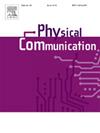JOPCNN-based hybrid precoding/combining algorithm for millimeter wave communication systems
IF 2
4区 计算机科学
Q3 ENGINEERING, ELECTRICAL & ELECTRONIC
引用次数: 0
Abstract
To enhance the wideband hybrid precoding/combining (HPC) performance, this paper presents an antenna selection-based joint optimization HPC algorithm, namely JOPCNN. In the proposed algorithm, a JOPCNN framework is constructed to obtain the optimal analog precoder and combiner. Specially, the JOPCNN includes antenna selection convolutional neural network(ASCNN) and hybrid precoding/combining convolutional neural network (HPCCNN) subnetworks. Firstly, to improve spectral efficiency(SE) while reducing hardware cost and complexity of the system, the purpose of the ASCNN is to get the best antenna arrays. Subsequently, by employing the analog phase matrix as a label, the HPCCNN subnetwork is able to output the best analog precoder and combiner while adhering to the constant modulus restriction. Meanwhile, in order to better extract the amplitude, phase, and carrier-related information of the channel, a 3-dimensional convolutional neural network(3DCNN) is introduced into the proposed JOPCNN model. Finally, the digital coder can be solved by employing the resulting analog coder. Simulation findings indicate that the suggested approach performs better in SE than comparable algorithms.
基于jopcnn的毫米波通信系统混合预编码/组合算法
为了提高宽带混合预编码/组合(HPC)性能,本文提出了一种基于天线选择的联合优化HPC算法JOPCNN。在该算法中,构建了JOPCNN框架以获得最优的模拟预编码器和组合器。特别是,JOPCNN包括天线选择卷积神经网络(ASCNN)和混合预编码/组合卷积神经网络(HPCCNN)子网络。首先,为了提高频谱效率(SE),同时降低系统的硬件成本和复杂性,ASCNN的目的是获得最佳的天线阵列。随后,通过采用模拟相位矩阵作为标签,HPCCNN子网能够在遵守恒模限制的情况下输出最佳模拟预编码器和组合器。同时,为了更好地提取信道的幅度、相位和载波相关信息,在JOPCNN模型中引入了三维卷积神经网络(3DCNN)。最后,利用所得到的模拟编码器求解数字编码器。仿真结果表明,该方法在SE上的性能优于同类算法。
本文章由计算机程序翻译,如有差异,请以英文原文为准。
求助全文
约1分钟内获得全文
求助全文
来源期刊

Physical Communication
ENGINEERING, ELECTRICAL & ELECTRONICTELECO-TELECOMMUNICATIONS
CiteScore
5.00
自引率
9.10%
发文量
212
审稿时长
55 days
期刊介绍:
PHYCOM: Physical Communication is an international and archival journal providing complete coverage of all topics of interest to those involved in all aspects of physical layer communications. Theoretical research contributions presenting new techniques, concepts or analyses, applied contributions reporting on experiences and experiments, and tutorials are published.
Topics of interest include but are not limited to:
Physical layer issues of Wireless Local Area Networks, WiMAX, Wireless Mesh Networks, Sensor and Ad Hoc Networks, PCS Systems; Radio access protocols and algorithms for the physical layer; Spread Spectrum Communications; Channel Modeling; Detection and Estimation; Modulation and Coding; Multiplexing and Carrier Techniques; Broadband Wireless Communications; Wireless Personal Communications; Multi-user Detection; Signal Separation and Interference rejection: Multimedia Communications over Wireless; DSP Applications to Wireless Systems; Experimental and Prototype Results; Multiple Access Techniques; Space-time Processing; Synchronization Techniques; Error Control Techniques; Cryptography; Software Radios; Tracking; Resource Allocation and Inference Management; Multi-rate and Multi-carrier Communications; Cross layer Design and Optimization; Propagation and Channel Characterization; OFDM Systems; MIMO Systems; Ultra-Wideband Communications; Cognitive Radio System Architectures; Platforms and Hardware Implementations for the Support of Cognitive, Radio Systems; Cognitive Radio Resource Management and Dynamic Spectrum Sharing.
 求助内容:
求助内容: 应助结果提醒方式:
应助结果提醒方式:


